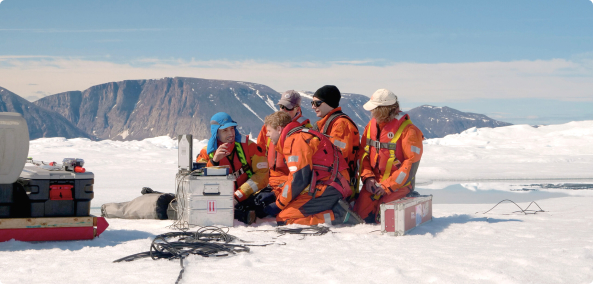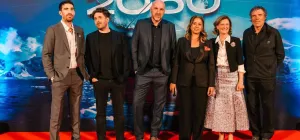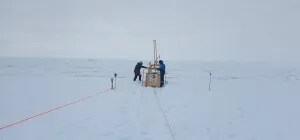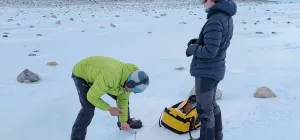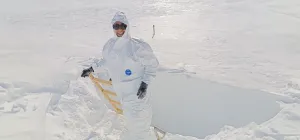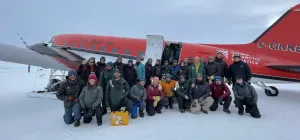New Batch of Scientists and Crew Arrive during Midseason Changeover
Several scientists and crew went home this past week as new scientists and crew arrived.

Several scientists and crew went home this past week as new scientists and crew arrived.
On Saturday, January 11th, teams from the Belspo-funded ULTIMO and FROID projects headed home after each undertaking a very successful field campaign along with several crew, including Simon Steffen and Doctor Martin Leittl who had been at the station for several weeks.
They were replaced by Eric Rignot and two colleagues from the University of California Irvine, who will work on the NISAR project; Paula Lampredapineda from the University of Ghent, who will spend five weeks in Antarctica for the BELSPO-financed PASPARTOUT project; and finally Bjorn and Quentin Vanhellemont, also from the University of Ghent, who will work on the BELSPO-financed EXPOSOILS project.
New crew members include field guides Daniel Mercier and Manu Poudelet. They will be responsible for the safety of the scientists while in the field.
After they finish the requisite field training, and after the IPF team finishes putting the touches on the logistical support, the scientists want to head into the field as soon as this coming weekend.
Examining ice shelf dynamics
Professor Rignot and his team hope to spend three weeks on the King Baudouin Ice Shelf studying how it’s being affected by warming atmospheric and ocean temperatures. They will use various methods to look at the thickness of the ice shelf from the grounding line to the tip of the ice shelf at the coast.
Firstly, they will set up a second automatic weather station on the edge of the ice shelf that Simon Steffen had prepared before leaving (for the PEACE project). This will complement the AWS already installed at the grounding line. They will also install a GNSS antenna in order to measure any rise or fall of the ice shelf over time.
At various locations along the ice shelf, Eric and his colleagues will drill holes in the ice with a hot water drill and lower a CTD sensor to measure conductivity, temperature and depth into the ocean beneath the hole. This will give them an idea of how quickly the ocean beneath the ice shelf is warming.
Finally, they will take ground radar transects by hauling a radar sounder behind a skidoo in a grid pattern. This will give them an image of how thick the ice shelf is over its entire length.
During their stay at the coast, they will have the luxury of having one of the modified living containers with them. The container put together by IPF engineers has internet, a snow melter, a kitchen, and a living area. This helps make extended stays away from the station a lot more comfortable.
As Alain and Tim will be nearby preparing for the arrival of the cargo ship towards the end of this month, they will provide assistance to Eric whenever necessary.
Studying atmospheric particles
This year, Paula Lampredapineda from the University of Ghent will continue work that she and her colleague Sibylle Boxho from the ULB started last year studying atmospheric particles, their origin, and how they are transported to Antarctica through the atmosphere for the BELSPO-funded PASPARTOUT project.
Paula will head out to the coast for 10 days with IPF field guide Manu Poudelet to revisit a location that Sibylle had visited last year. This location is not far from where Eric will be stationed and where Alain and Tim will prepare for the offloading of the cargo ship.
Paula will bring to the coast a volatile organic compound (VOC) automatic sampler she had installed at PEA last season so it can start taking samples at the coast. Alain had installed a support battery pack, wind turbine, and solar panel so the VOC sampler can run autonomously for the entire winter.
At this location Sibylle Boxho installed a precipitation/snow sampler last season. The sampler rotated automatically every three months to collect precipitation from each of the year’s quarters. Paula will collect the precipitation samples and bring them back to Belgium for analysis.
Paula will also repeat what Sibylle did last year: dig a two-metre deep trench in the snow and sample snow layers going back several years to determine what kind of atmospheric particles have been transported to Antarctica over this period of time.
As Paula only plans to be at the coast for 10 days or so, she and Manu will camp out in tents. Conditions at the coast tend to be warmer and milder in general, so they should have an easy stay.
Sergi Gonzalez from the EPFL will also join them to continue taking photogrammetry of the snow surface over square metres for the CRYOS project along with snow samples at different depths.
Sampling microbial life
The BELSO-funded EXPOSOILS project is back at the station, with Björn Tytgat and Quentin Vanhellemont from the University of Ghent representing the project this year.
During their month-long stay, they plan to revisit nunataks the project has visited several times to take samples of microbial life in their regular locations, during day trips not far from the station.
They will also collect temperature and humidity loggers, check open top chambers installed on most nunataks near the station. They will also get data from their time lapse cameras installed last season that can monitor how much snow accumulates and how much is ablated when the sun hits it.
Preparing for the ship to arrive
The big logistical task BELARE Team Leader Alain Hubert, Tim Grosrenaud, and the rest of the IPF team need to prepare for is the arrival of the cargo ship, scheduled to arrive on January 24th. Alain and Tim have been doing reconnaissance over the past several weeks along the Princess Ragnhild coast to find the best place for the ship to offload each time they’ve been in the area.
On the ship will be fresh food for the rest of the season and the following one, supplies for the station, materials for a hangar the team plans to construct during next season, and fuel for the vehicles. The ship will take back with it ice core samples the FROID project took during the season along with samples from the ULTIMO project (mostly sediments to be sorted to find micro-meteorites) and logistical equipment for the next season (transportation boxes, reefer etc).
It takes years of expertise to make sure the offloading process goes safely and smoothly. Alain and the IPF team have what it takes to make sure it gets done properly!
Download